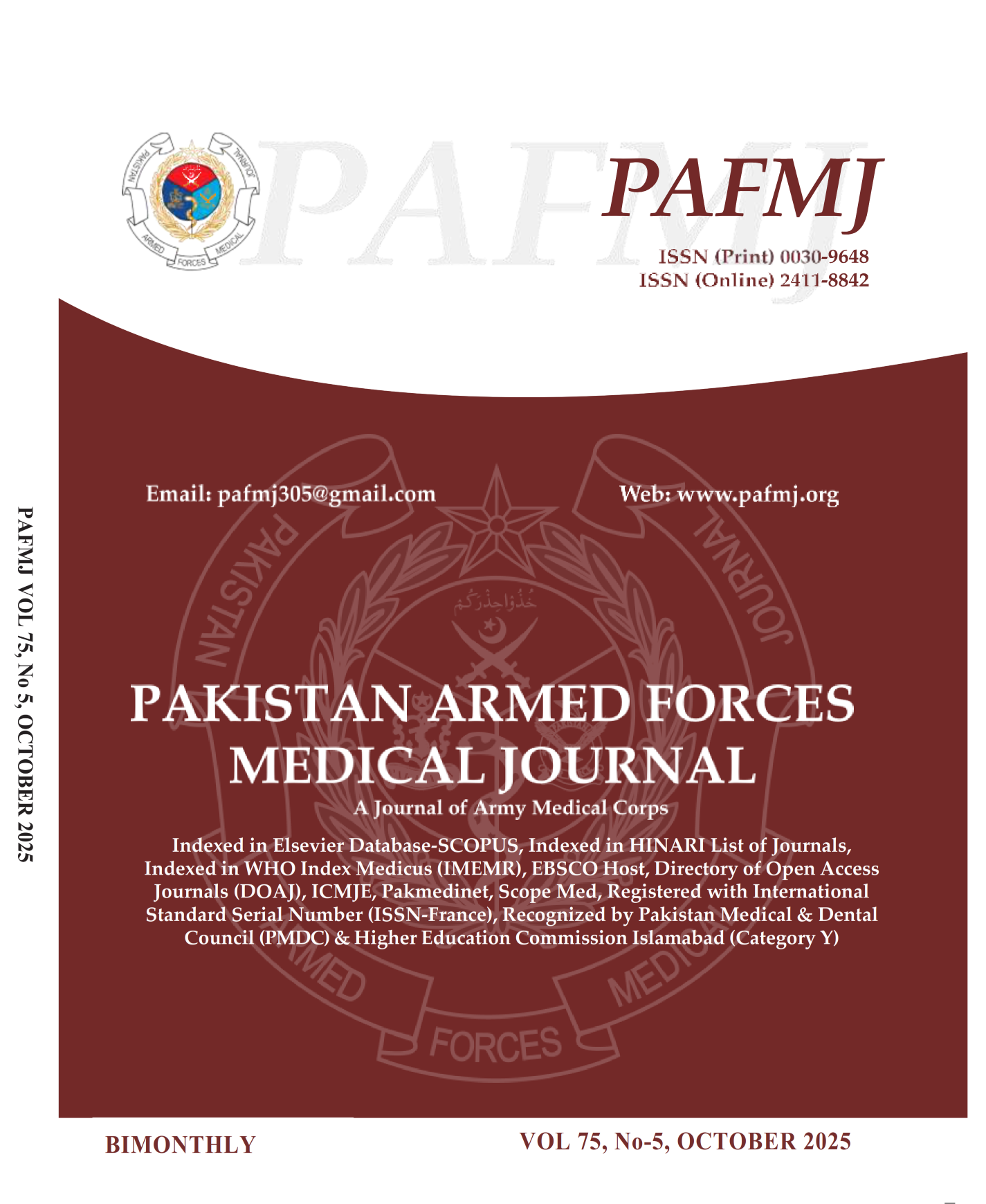Influencing the Need for Multiple Peripheral Intravenous Cannulations in Adult Inpatients
DOI:
https://doi.org/10.51253/pafmj.v75i5.10228Keywords:
Cannula, Complications, Intravenous Administration, Intravenous Infusions, Peripheral Catheterization, Vascular Access DevicesAbstract
Objective: To identify factors predictive of the need for repeated peripheral intravenous cannulations in hospitalized patients.
Study Design: Prospective longitudinal study.
Place and Duration of Study: Pak Emirates Military Hospital, Rawalpindi, Pakistan, from Jan to Feb 2023
Methodology: Adult patients hospitalized for more than two days and with peripheral intravenous cannulas were required for IV injections. Exclusion criteria included the requirement of more than one cannula simultaneously, cannulation of lower extremity veins, and unwillingness. Data on the number, site, size, dwell time, and reason for removal of cannulas were recorded.
Results: There were 615 patients with a median age of 48 years (interquartile range: 32- 63 years), including 490(79.67%) males, who remained admitted for 5.87±2.17 days. A total of 1236 cannulas were inserted, accounting for 2.01±0.83 cannulas per patient, with a mean dwell time of 2.57±0.75 days. 692(55.99%) cannulas were placed on right side and 544(44.01%) on left; 616(49.17%) were passed over the forearms/ antecubital fossa and 620(50.83%) over wrists/ dorsum of hands. Single cannulation was required in 187(30.41%) patients, whereas 428(69.59%) required repeated insertions. Of the 1049 repeat cannulations, 541(51.57%), 63(6.01%), and 17(1.62%) had to be undone because of blockade, dislodgement, and thrombophlebitis, respectively. Increasing patient age (odds ratio 1.026), smaller cannula size (odds ratio 3.497), and placement of cannulas on wrist/ dorsal aspect (odds ratio 3.497) or left upper extremity (odds ratio 1.574) were associated with a subsequent need for repeat cannulation.
Conclusion: The frequency of repeated intravenous cannulations may be minimized by selecting appropriately sized larger-bore cannulas.
Downloads
References
1. Pasalioglu KB, Kaya H. Catheter indwell time and phlebitis development during peripheral intravenous catheter administration. Pak J Med Sci 2014; 30(4): 725-730.
2. Data Bridge Market Research. Global peripheral intravenous (IV) catheter market – Industry trends and forecast to 2029. Vancouver: [Internet]. Available at:
https://www.databridgemarketresearch.com/reports/global-peripheral-intravenous-iv-catheter-market
3. Shahnaz A, Bashir M, Khan B. Incidence of phlebitis with intravascular cannulas in surgical patients during the postoperative period. Pak J Med Dent 2021; 10(2): 68-73.
https://doi.org/10.36283/PJMD10-2/012
4. Marsh N, Larsen EN, Takashima M, Kleidon T, Keogh S, Ullman AJ, et al. Peripheral intravenous catheter failure: A secondary analysis of risks from 11,830 catheters. Int J Nurs Stud 2021; 124: 104095. https://doi.org/10.1016/j.ijnurstu.2021.104095
5. O'Grady NP, Alexander M, Burns LA, Dellinger EP, Garland J, Heard SO, et al. Healthcare Infection Control Practices Advisory Committee (HICPAC). Guidelines for the prevention of intravascular catheter-related infections. Clin Infect Dis 2011; 52(9): e162-93. https://doi.org/10.1093/cid/cir257
6. Webster J, Osborne S, Rickard CM, Marsh N. Clinically-indicated replacement versus routine replacement of peripheral venous catheters. Cochrane Database Syst Rev 2019; 1(1): CD007798. https://doi.org/10.1002/14651858.cd007798.pub4
7. Rasheed A, Basheer F, Iqbal T, Hassan SK. Real time ultrasound guided practice in passing central venous pressure line in pediatric population. J Dow Univ Health Sci 2021; 15(3): 149-154.
https://doi.org/10.36570/jduhs.2021.3.1190
8. Marsh N, Webster J, Ullman AJ, Mihala G, Cooke M, Chopra V, et al. Peripheral intravenous catheter non-infectious complications in adults: A systematic review and meta-analysis. J Adv Nurs 2020; 76(12): 3346-3362.
https://doi.org/10.1111/jan.14565
9. Panza GA, Steere L, Steinberg AC. A new force-activated separation device for the prevention of peripheral intravenous restarts. J Infus Nurs 2022; 45(2): 74-80.
https://doi.org/10.1097/nan.0000000000000455
10. Simin D, Milutinović D, Turkulov V, Brkić S. Incidence, severity, and risk factors of peripheral intravenous cannula-induced complications: An observational prospective study. J Clin Nurs 2019; 28(9-10): 1585-1599. https://doi.org/10.1111/jocn.14760
11. Infusion Nurses Society. Infusion Nursing Standards of Practice. J Infus Nurs 2016; 36: 1–159.
https://doi.org/10.1097/nhh.0000000000000481
12. Lv L, Zhang J. The incidence and risk of infusion phlebitis with peripheral intravenous catheters: A meta-analysis. J Vasc Access 2020; 21(3): 342-349. https://doi.org/10.1177/1129729819877323
13. Chen YM, Fan XW, Liu MH, Wang J, Yang YQ, Su YF. Risk factors for peripheral venous catheter failure: A prospective cohort study of 5345 patients. J Vasc Access 2022; 23(6): 911-921.
https://doi.org/10.1177/11297298211015035
14. Takahashi T, Murayama R, Abe-Doi M, Miyahara-Kaneko M, Kanno C, Nakamura M, et al. Preventing peripheral intravenous catheter failure by reducing mechanical irritation. Sci Rep 2020; 10(1): 1550. https://doi.org/10.1038/s41598-019-56873-2
15. Blanco-Mavillard I, Rodríguez-Calero MÁ, de Pedro-Gómez J, Parra-García G, Fernández-Fernández I, Castro-Sánchez E. Incidence of peripheral intravenous catheter failure among inpatients: variability between microbiological data and clinical signs and symptoms. Antimicrob Resist Infect Control 2019; 8: 124. https://doi.org/10.1186/s13756-019-0581-8
16. Kassahun CW, Abate AT, Tezera ZB, Beshah DT, Agegnehu CD, Getnet MA, et al. Incidence and associated factors of failed first peripheral intravenous catheters among adult patients at medical surgical wards in public referral hospitals of West Amhara, Ethiopia, 2021. Nurs Res Pract 2022; 22: 2022: 8261225.
https://doi.org/10.1155/2022/8261225
17. Wallis MC, McGrail M, Webster J, Marsh N, Gowardman J, Playford EG, et al. Risk factors for peripheral intravenous catheter failure: a multivariate analysis of data from a randomized controlled trial. Infect Control Hosp Epidemiol 2014; 35(1): 63-68. https://doi.org/10.1086/674398
18. Prakash S, Arora G, Rani HS. Peripheral venous access in the obese patient. Indian J Anaesth 2015; 59(10): 692-693.
https://doi:10.4103/0019-5049.167482
19. Kashiura M, Yasuda H, Oishi T, Kishihara Y, Moriya T, Kotani Y, et al. Risk factors for peripheral venous catheter-related phlebitis stratified by body mass index in critically ill patients: A post-hoc analysis of the AMOR-VENUS study. Front Med 2022; 9: 1037274. https://doi.org/10.3389/fmed.2022.1037274
20. Atay S, Yilmaz Kurt F. Effectiveness of transparent film dressing for peripheral intravenous catheter. J Vasc Access 2021; 22(1): 135-140. https://doi.org/10.1177/1129729820927238
21. Abolfotouh MA, Salam M, Bani-Mustafa A, White D, Balkhy HH. Prospective study of incidence and predictors of peripheral intravenous catheter-induced complications. Ther Clin Risk Manag 2014; 10: 993-1001. https doi:10.2147/TCRM.S74685
Downloads
Published
Issue
Section
License
Copyright (c) 2025 Farhan Ahmed, Abdul Rehman Arshad, Ghulam Abbas Khan Niazi, Abdul Rehman Azeem Dar, Amir Rashid, Usama Zahid

This work is licensed under a Creative Commons Attribution-NonCommercial 4.0 International License.















